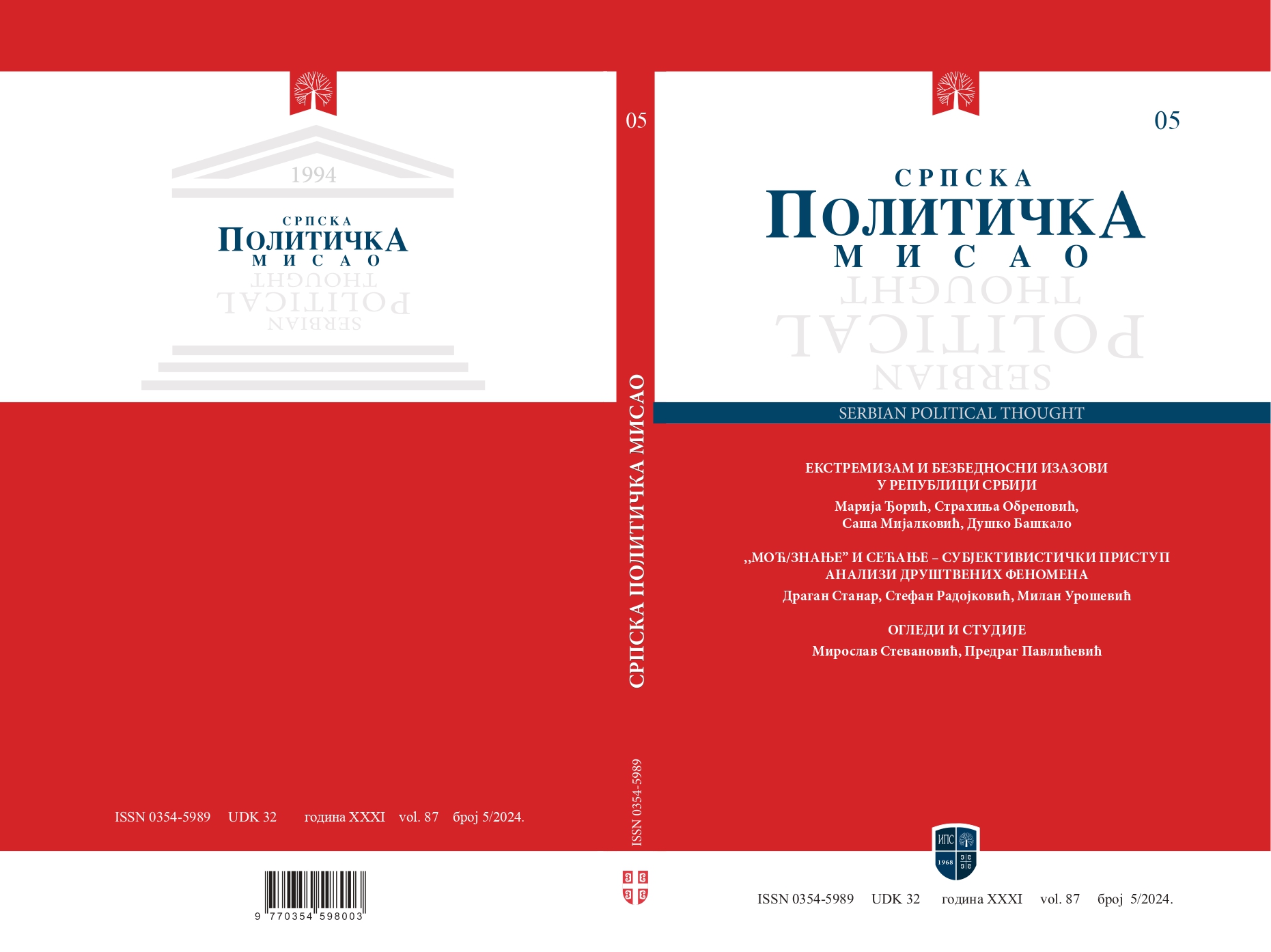FOREIGN TERRORIST FIGHTERS AS A POTENTIAL SECURITY PROBLEM OF THE REPUBLIC OF SERBIA
Abstract
The paper analyzes the phenomenon of foreign terrorist fighters, who can represent a potential security problem for the Republic of Serbia. It is believed that in the period from 2012 to 2016, more than 1,200 people from the Western Balkan region (including Serbia, as well). The fact that 49 Serbian adult citizens went to Syria (37 men and 12 women) is very important. Authors first made a distinction between the terms foreign fighters and foreign terrorist fighters, so that in the continuation of the work the focus would be on the classification of this phenomenon. Although foreign fighters appeared much earlier, the focus of this research is on the war in Syria, which involved a large number of international actors, including terrorist organizations, such as the „Islamic State”. The central part of the work is dedicated to the institutional and strategic framework of the Republic of Serbia, which deals with the prevention and fight against violent extremism and terrorism. In addition, the authors analyzed all potential phases (and at the same time the problem) of the return of foreign terrorist fighters, as well as their families in the territory of the Republic of Serbia, giving predictive analyses. The return of foreign terrorist fighters from Syria and Iraq to the territory of the Republic of Serbia can represent a kind of security problem. This phenomenon has been unknown until now, especially when it comes to group face restoration. In addition, this is not only about one category (eg terrorists), but we will also meet with women and children. Up until now, in the region, women have mostly been viewed as victims, but it should be borne in mind that individual members of the female gender can also be radicalized, which can have a negative impact on children as well, through the process of education. Due to all these facts, a multidisciplinary approach to this problem is necessary, which will involve experts from different fields.
References
Al Jazeera. 2018. „Osuđenima za terorizam u Srbiji ukupno 67 godina zatvora.” Al Jazeera. Poslednji pristup 18 jun 2024. https://balkans.aljazeera.net/news/balkan/2018/4/4/osudenima-za-terorizam-u-srbiji-ukupno-67-godina-zatvora.
Buljubašić, Mirza, i Vlado Azinović. 2023. Krivično procesuiranje stranih terorističkih boraca u Bosni i Hercegovini. Atlantska inicijativa: Sarajevo
Bloomberg. 2016. “The Geography of Foreign ISIS Fighters.” Bloomberg. Last accessed 30 May 2024. https://www.bloomberg.com/news/articles/2016-08-10/the-geography-of-foreign-isis-fighters.
CNN. 2024. “In prison because of our parents: Children of ISIS fighters coming of age in detention ask what they’re being punished for.” CNN. Last accessed 17 Jun 2024. https://edition.cnn.com/2024/06/11/middleeast/isis-children-detention-syria-intl-cmd/index.html.
Coolsaet, Rik. 2016. Facing the Fourth Foreign Fighters Wave – What Drives Europeans to Syria, and to Islamic State? Insights from the Belgian State. Last accessed 30 May 2024. https://www.egmontinstitute.be/facing-the-fourth-foreign-fighters-wave/.
Corner, Emily, and Paul Gill. 2015. “A false dichotomy? Mental illness and lone-actor terrorism.” Law and Human Behavior 39 (1), 23–34. doi: 10.1037/lhb0000102.
Council of Europe. 2015. Explanatory Report to the Additional Protocol to the Council of Europe Convention on the Prevention of Terrorism. Last accessed 25 May 2024. https://rm.coe.int/168047c5ea.
Dedeken, Kjara, i Kevin Ozborn. 2021. Repatrijacija stranih terorističkih boraca iz Sirije: lekcije sa Zapadnog Balkana. Poslednji pristup 12 jun 2024. https://resolvenet.org/sites/default/files/Policy%20Note%20%20Repatriating%20FTFs%20from%20Syria_Serbian.pdf.
Đorić, Marija. 2024. „Istraživanje korelacije mentalnih poremećaja i terorizma.” Srpska politička misao 85 (3): 39–58. doi: 10.5937/spm85-50255.
Đorić, Marija. 2023. “How to deal with violent extremism in the Western Balkans?” In How to deal with uncertainties in increasingly complex environment?: (the new cartography of risk and crises), eds. Zoran Keković, Ratko Duev and Jadranka Polović, 11–24. Skopje: Faculty of philosophy/Institute for security, defense and peace „Ss. Cyril and Methodius” university; Belgrade: Center for risk analysis and crisis management (CARUK).
Geneva Academy of International Humanitarian Law and Human Rights Academy. 2014. Briefing (Kratko saopštenje akademije) No. 7 – Foreign Fighters under International Law. Geneva: Geneva Academy of International Humanitarian Law and Human Rights Academy.
Krivični zakonik, „Sl. glasnik RS”, br. 85/2005, 88/2005 - ispr., 107/2005 - ispr., 72/2009, 111/2009, 121/2012, 104/2013, 108/2014, 94/2016 i 35/2019. Poslednji pristup 14 jun 2024.
Milošević, Zoran, i Miša Stojadinović. 2024. „Društvene nauke i nacionalna bezbednost.” Politika nacionalne bezbednosti 26 (1): 27–44. doi: 10.5937/pnb26-50574.
Muzej istorije Jugoslavije. 2006. U čast španskih boraca: arhivski materijal, svedočenja, sećanja. Beograd: Muzej istorije Jugoslavije.
Odluka o obrazovanju NKT za sprečavanje i borbu protiv terorizma i određivanju i imenovanju Nacionalnog koordinatora za sprečavanje i borbu protiv terorizma [Odluka o obrazovanju NKT], „Službeni glasnik RS”, br. 58/2023 i 10/2024.
Proroković, Dušan, i Marko Parezanović. 2023. „Veštačka inteligencija i psihološko-propagandne operacije u kontekstu ugrožavanja nacionalne bezbednosti.” Politika nacionalne bezbednosti 25 (2): 13–2. doi: https://doi.org/10.5937/pnb25-46741.
Simi, Pete et al. 2016. “Narratives of childhood adversity and adolescent misconduct as precursors to violent extremism: A life-course criminological approach.” Journal of Research in Crime and Delinquency 53(4), 536–563. doi: 10.1177/0022427815627312.
Slobodna Evropa. 2018. „Višegodišnje kazne građanima Srbije zbog ratovanja u Siriji.” Slobodna Evropa. Poslednji pristup 12 jun 2024. https://www.slobodnaevropa.org/a/srbija-sirija-presuda/29142854.html.
Stanar, Dragan. 2020. „Vojska i terorizam: alternativna perspektiva opravdanosti upotrebe oružanih snaga protiv terorizma”. Politička revija 65 (3): 73–93. doi: 10.22182/pr.6532020.4.
Subotić, Milovan. 2017. „Konfliktni potencijal potisnutog islamističkog ekstremizma na Kosovu i Metohiji.” Politika nacionalne bezbednosti (2), 143–157. doi: 10.22182/pnb.22017.8.
UN. 2014. Rezolucija 2178 Saveta bezbjednosti UN. Last accessed 6 May 2024. https://www.un.org/securitycouncil/s/res/2178-%282014%29.
UNODC. 2017. Strani teroristički borci: priručnik za institucije za obuku sudija i tužilaca u Jugoistočnoj Evropi. Beč: UNODC.
Venhaus, John M. 2010. Special Report 236: Why Youth Join al-Qaeda. Washington: United States Institute for Peace.
Zelin, Aaron. 2024. Local branches now control territory in Mali, Somalia, and Mozambique, setting the stage for new foreign fighter mobilizations, resource extraction opportunities, and perhaps even external operations against the West. Last accessed 12 Jun 2024. https://www.washingtoninstitute.org/policy-analysis/islamic-state-march-africa.

